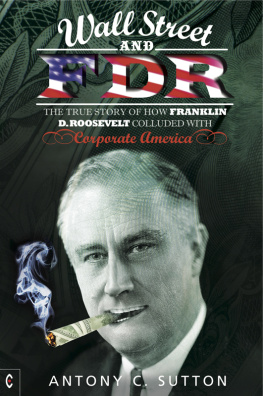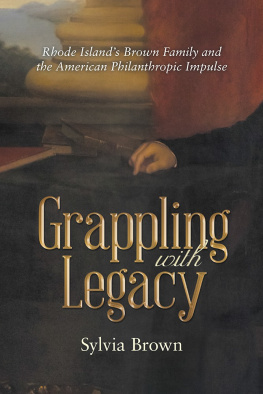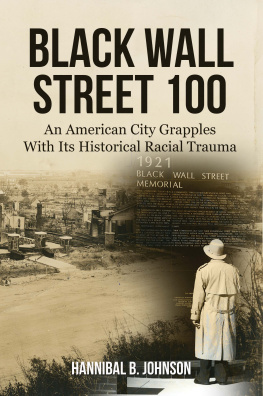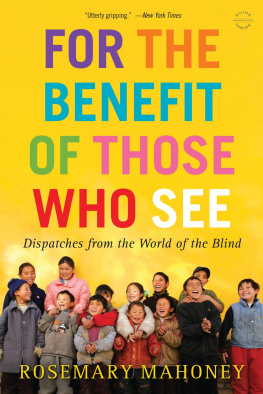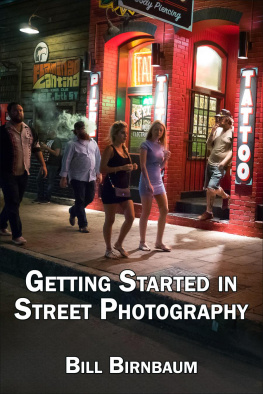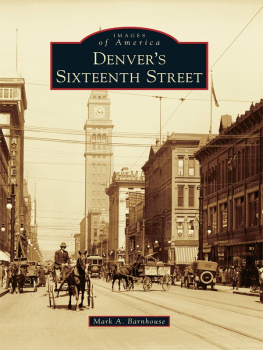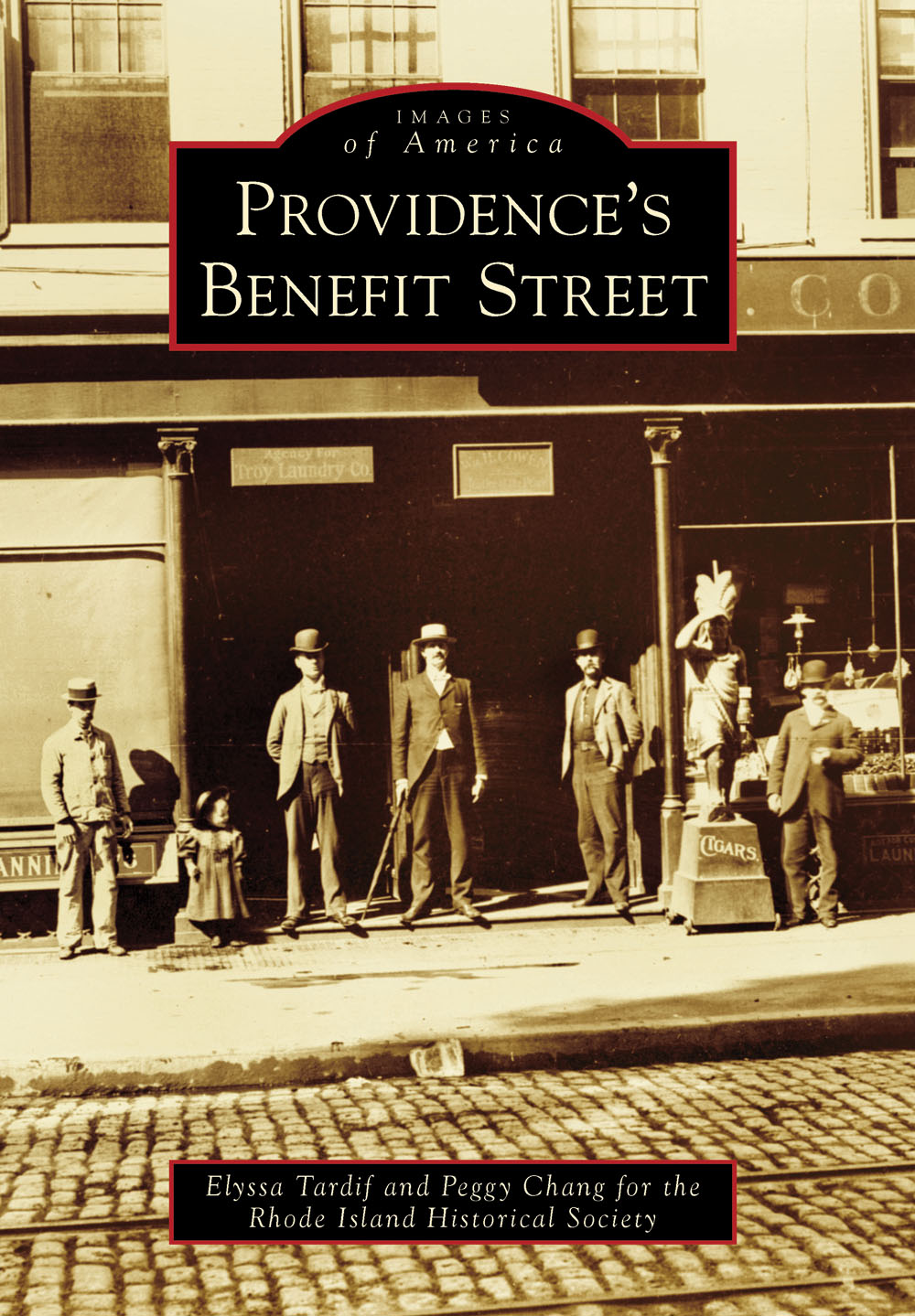
IMAGES
of America
PROVIDENCES
BENEFIT STREET

This topographical chart of Rhode Island, by cartographer Charles Blaskowitz (17431823), was engraved and published by William Faden (17491836) in 1777. The chart shows various large farms across Rhode Island. Benefit Street appears in the top left corner of the map. (Courtesy of the Rhode Island Historical Society.)
ON THE COVER: This c. 1895 image shows the establishment of William H. Cowen, a cigar dealer, one block west of Benefit Street at the corner of North Main and Steeple Streets. Many businesses lined the streets below Benefit Street during the turn of the 20th century. (Courtesy of the Rhode Island Historical Society.)
IMAGES
of America
PROVIDENCES
BENEFIT STREET
Elyssa Tardif and Peggy Chang
for the Rhode Island Historical Society

Copyright 2013 by Elyssa Tardif and Peggy Chang for the Rhode Island Historical Society
ISBN 978-0-7385-9923-6
Ebook ISBN 9781439643471
Published by Arcadia Publishing
Charleston, South Carolina
Library of Congress Control Number: 2012953973
For all general information, please contact Arcadia Publishing:
Telephone 843-853-2070
Fax 843-853-0044
E-mail
For customer service and orders:
Toll-Free 1-888-313-2665
Visit us on the Internet at www.arcadiapublishing.com
To those throughout the centuries who have traversed this mile of history.
CONTENTS
ACKNOWLEDGMENTS
We are indebted to many people who generously gave their time to assist in this project. Dr. Morgan Grefe, executive director at the Rhode Island Historical Society, encouraged the project from its conception. J.D. Kay, rights and reproductions extraordinaire at the Rhode Island Historical Society, worked tirelessly to collect and process our images. Dr. Rebecca More, Dr. Anne Valk, Dr. Stanley Lemons, Lou Costa, Phoebe S. Bean, Sarah Zurier, and Ed Hooks provided crucial insight and support. We are grateful to Katie McAlpin at Arcadia Publishing for her consistent, cheerful guidance. The work on this project was in part inspired by Mildred Nichols and Goodwill Industries RI, and their interest in the Irrepressible Society, from which they trace their founding.
A thousand thanks from E.T. are due to Barbara Barnes, tourism services manager at the Rhode Island Historical Society. Barbara is an incomparable expert on Benefit Street, a thoroughfare that she loves dearly and that she honors with her excellent walking tours. P.C. would like to thank Tai and Lina Chang and Scott Horton.
Finally, heartfelt thanks to Karen Tardif, Cassandra Tardif, and Stefan Kaszycki for their generosity and limitless patience.
All images appear courtesy of the Rhode Island Historical Society.
INTRODUCTION
Providence is a city steeped in history. Evidence of this rich history appears nearly everywhere you look, from the 19th-century facades on Westminster Street to the marbled halls of the statehouse, constructed c. 1901. Even the street signs bear witness to people and structures that have come and gone. Power Street, once Powers Lane, runs the property line of early Providence resident Nicholas Power. Meeting Street was once known as Gaol Lane, where one of Providences early jails was once located. Transit and Planet Streets commemorate the observation of the transit of Venus, which took place in Providence in 1769.
Benefit Streets name, too, holds layers of meaning and underscores its past importance to the Providence community. Formerly known as Back Street, it ran along the back of many residences, parallel to what was then known as Towne Street. Benefit Street was carved out between 1756 and 1758 for, as the town would later explain, the common benefit of all. Officially known by 1772 as Benefit Street, the thoroughfare saw houses spring up quickly as certain residents seized the opportunity to build higher on the ridge while still remaining within their property limits. This was possible because of the very narrow, but long, plots that Roger Williams established after 1636, following his banishment from the Massachusetts Bay Colony. In the 17th century, family plots began at the waters edge and extended up the hill; residences were built closer to the water, and the hillside was used for the planting of fruit orchards.
Although the town center began in the early 1700s at the site that now encompasses the Roger Williams National Memorial, the heart of the town ultimately moved south and west, with the Great Salt River and Salt Cove as crucial central points. While Providence was primarily a planting community in the 17th century, maritime commerce would begin to emerge as a way by which some individuals, like John Brown, whose mansion sits along Benefit Street at 52 Power Street, became very wealthy. Earlier in the 18th century, most Providence residents lived on the east side of Towne Street, with the wharves and warehouses used by merchants along the waterfront. At the close of the 18th century, Benefit Street saw the new construction of houses by wealthier residents, and a new surveying of Benefit Street necessitated the removal of most family burial plots to make way for the thoroughfare. With the 19th century, institutions like the Providence Athenaeum and the Rhode Island School of Design were formed, as Providence men and women worked toward creating an artistic and literary stronghold along Benefit Street. The 20th century saw an influx of immigrants to Rhode Island, and the Benefit Street neighborhood followed this trend, as families from Portugal, Cape Verde, and Ireland settled in the south end known as Fox Point. Thus, Benefit Street can be seen as a microcosm of Rhode Island, home to individuals of different professions, faiths, and socioeconomic statuses, all bound together geographically.
It would be impossible to tell the story of Benefit Street without telling that of its sister streets, including North Main, South Main, and Wickenden Streets. While historically Benefit Street has been the location of residences, houses of worship, and educational institutions, these sites would not exist without the businesses that lined North Main Street or the wharves that marked South Water Street. These streets paint a fuller, richer picture of the nexus that Benefit Street formed in the heart of Providence.
Although this book begins chronologically in the first chapter, the following chapters are organized by theme, emphasizing the variety of communities and personalities that have left their mark on Benefit Street. offers a virtual walking tour of Benefit Street in the 19th and early 20th centuries.
We are afforded these glimpses into the past because photographers like Frank Warren Marshall, John Hess, and Charlotte Estey took it upon themselves to document the beauty of their surroundings, a street that so many have called home for more than two centuries.
One
EARLY YEARS

Alvan Fisher (17921863) painted Providence from Across the Cove in 1819 from the perspective of Smith Hill. The Great Salt Cove, as it was known, was fed by waters from the Moshassuck River from the north and the Woonasquatucket River from the west. Adjacent to the cove was a freshwater spring, which was the area on which Roger Williams decided to settle.
Next page


